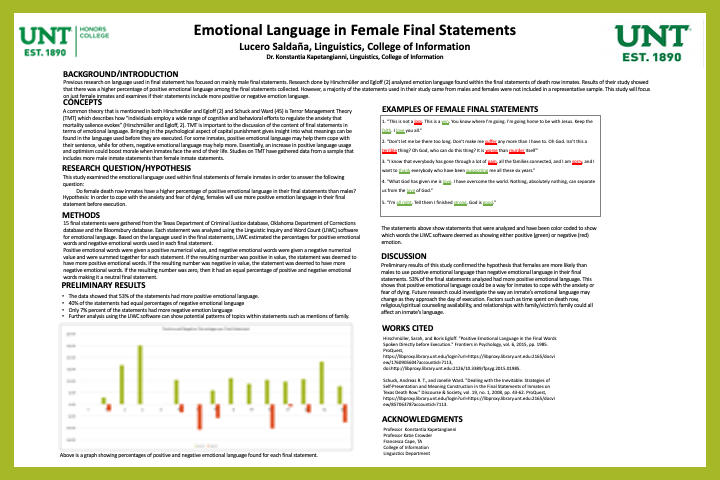First Name:
LuceroLast Name:
SaldanaMentor:
Dr. Konstantia KapetangianniAbstract:
While many forensic linguistics studies, such as Hirschmüller and Egloff’s (2015) study, have analyzed final statements of death row inmates, few have focused on those given by female inmates. According to the Texas Department of Criminal Justice (TDCJ), only 2.8% of inmates on death row are female. This means that studies that analyze final statements have data from mainly male perspectives and there is a disproportion in gender. Previous studies, such as Shuck and Ward’s (2008) study, have focused on the content of final statements, such as recurring themes or the emotional language. The findings included recurring themes of apology and religious mentions. Data collected in previous studies is a majority from male inmates. The aim of this study is to focus on the final statements of women and is based on methods from Hirschmüller and Egloff’s (2015) study. Research questions in this study analyzed whether female final statements had a higher percentage of positive emotional language than in male final statements. Fifteen final statements of the female inmates that have been executed since 1982 were analyzed using the Linguistic Inquiry and Word Count (LIWC) text analysis program. Final statements were collected from the TDCJ database, the Oklahoma Department of Corrections database, and the Bloomsbury database of death row documents. Each final statement will be analyzed for positive and negative emotional language as well as for recurring themes. Positive emotional language includes mentions of words such as ‘love’ or ‘happy.’ Negative emotional language includes mentions of words such as ‘sad’ or ‘death.’ Preliminary results have shown a high percentage of positive emotional language and there are recurring mentions of words belonging to the category of family, especially words for children such as ‘daughter’ and ‘son.’
Poster:





